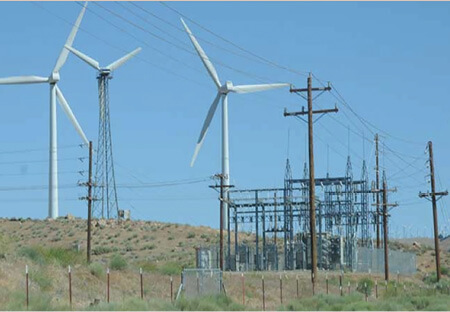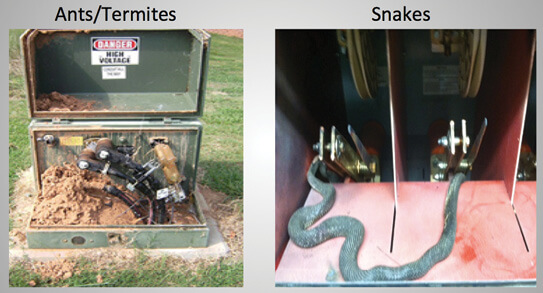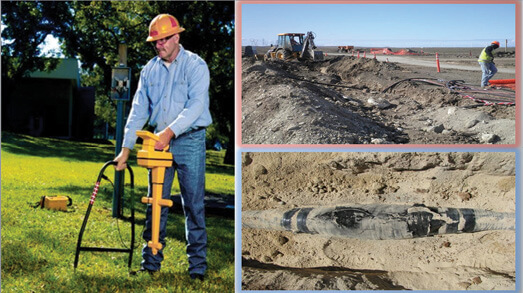By Bruce Hammett, President
WECS Electric
Throughout the life of every wind farm, many challenges arise that will need attention to keep its turbines generating power. What begins with choices concerning turbine size and proper installation leads to decision on O&M and repairs.
Typically, the more proactive and organized a site owner, the better. However, transmission is an element often left off the table during discussions on maximizing power production. Without a grid, generating usable power becomes a pointless exercise.

When developing an O&M plan for a wind farm, remember to include the substation, collection lines, and overhead transmission lines.
Every wind farm starts with a site design that basically includes two parts: the wind turbines and the balance of plant (BoP). BoP is a term given to the supporting infrastructure of a wind farm that does not include the turbines — such as the substation and connection system.
There are a lot of components inside a wind turbine and if they break or need repairs, their owner and operators are faced with a downed turbine. BoP is much the same, except that one faulty wire can affect an entire wind farm’s power-generating capacity. So how do wind-farm owners optimize the BoP operations? And what is a reliable O&M strategy for electrical components?
First, it is important to define the different segments of the balance of plant.
- The substation is part of the electrical generation system that gets power from turbines to the grid, and that includes a number of components working at voltages of 35 kV and below. A well-designed substation includes redundancy to avoid or override failures (though not all of today’s wind farms support this feature) and a breaker in the middle that separates its two sides. The high-voltage section is the one that’s connected to the utility.
- A collection system is a combination of components but mainly consists of underground cable, which collects energy from each wind turbine. Sometimes the cable spiders out into three or four different directions, and eventually flows back to one breaker. It is connected and interconnected through various types of apparatus, rubber goods, T bodies, and splices — and, with so many parts, good installation is key. The collection system should help minimize losses and voltage drops.
- Turbine indicator-connect is a recent BoP addition. At one time as many as 13 turbines were connected through a pad-mounted transformer. Modern technology has brought the 35-kV circuit breaker and tower base, which means the indicator-connect is now part of each turbine and the collection system.
- Sub transmission is the underground portion of the BoP that connects to each wind turbine.
- Overhead transmission includes the above-ground lines. This is either inside the 35-kV grid on substation grounds, or it represents the high-voltage energy that’s going out to the purchasing utility.
- Transmission is the lines that take power from a wind site to a location that can be 10 to 1,000 miles away.
Beyond turbine health
For the most part, wind turbines can withstand wind, rain, snow, lightning, electrical shocks, vibrations, and more. Today’s turbine owners would not expect less. The balance of plant of a wind farm must face these elements, too, and somehow house and maintain electricity safely and securely.
Most BoP operations were developed by a utility as an interconnected system of electrical wires, connectors, and protectors. Chances are, the lowest bidder also installed the system. However competent in operation, its design was based on the utility industry and was only theoretical in terms of the wind farm and the various potential turbines at a site. For example, a substation might be designed for a specific wind farm, but a mile or two away it must connect to another substation with completely different technology, or one from another utility. It might also have to work side-by-side with Siemens and GE turbines.
So BoP is essentially placed into a living organism — a wind farm with moving turbines — that can change in an instant depending on the direction of the wind or weather, or even the turbine capacity. To date, the best of educated minds have yet to determined how everything is supposed to fit together within a wind farm and without a hitch.
Nature is not always your friend
Lightning is just one issue that wind farms have to deal with at the turbine level. It is also extremely dangerous and damaging to a collection system — quite possibly all the way back through to the utility interconnect. Rain is also a concern. Then there are winters that bring all kinds of frost and icing scenarios that can affect BoP operations depending on the location.

Depending on a wind farm’s location, opening the door of a substation to find a snake (or other critter) is one of the potential hazards of the job for a balance-of-plant technician or electrician. Even ants and termites can infest and ruin expensive electrical equipment.
Weather aside, nature’s creatures and critters also pose a threat. The type of critter will vary by region, but here are some examples:
- Termites, ants, mice, and snakes. These hungry pests seem to love a good cable to gnaw on or substation to hide in. Many hours of concern have been taken at various wind sites to get rid of rattlesnakes, only to open a substation door and find one there.
- Cows and bulls. These guys laze around the field and they look for something to scratch their side or back on. Bulls are certainly not easy to deal with, but they can take out a junction box, ruin a pad-mounted transformer, and destroy a switchyard. If not careful, they can also ruin the day of a technician who is servicing equipment. Safety is paramount, and electricity at a substation is not the only concern.
- Texas turkey buzzard (and other birds). These birds have a massive wingspan. For some reason, they are not adverse to flying into live components within a switchyard, hurting themselves and possibly taking out the entire system.
- Prey. Eagles have been known to drop their prey, and sometimes in the worst location on power lines.
Plan of attack
Just like for a wind turbine, owners and operators must prepare for known and unknown circumstances when it comes to operating BoP. A good plan of attack involves planning for potential and unexpected problems — and includes the who, what, when, where, and how.
For example, say a rat chewed through a cable at a substation, then a storm hits, and a transformer blows up. Oil is everywhere. Is there a containment and cleanup strategy in place? As the site owner, do you have in-house capabilities or have you already planned for a subcontractor, and are they available on speed dial? Damage equates to downtime, so know your site, the resources, and have a plan.
- Location, location, location. Weather that can damage wind turbines can also damage substation and components in the collection system. Wind farms in the bitter cold of Alaska are going to face different conditions than in sunny, earthquake-prone California. Know your location and its potential environmental risks.
- Know your system. Some questions to consider: What do you do when something blows up? Is there a plan in place to fix things? Do you have the paperwork for each part and service agreement? Take vendor relationships seriously, and know who to call and when. It could be a manufacturer, distributor, or an independent service provider, and it might be someone different for each component. Also, prepare for the unexpected by having repair tools and materials, such as cleaners, readily accessible. For example, if you have to redo a splice without proper cleaner, you still won’t have a good splice after the repair.
-

Lightning doesn’t only pose a risk to wind turbines and their blades. It is also extremely dangerous and damaging to a collection system, and often all the way back to the utility interconnect.
Repair or replace? Imagine replacing a turbine or two in an older fleet. So you have an early GE working next to a brand new Siemens turbine, or vice versa. What’s going on between the turbines in terms of the types of energy (voltage and current) that each of those turbines is generating, and how will it react in the substation and in the collection system? This scenario could easily blow out all of the arrestors within a substation or throughout the entire system.
- Lead times. Suppose a particular splice needs replacing. Chances are it is not a great problem because in the right place, it’s possible to find hundreds of them on the shelf. But parts such as insulators, major switches, and pad-mounted or current transformers carry lead times. If something unexpected goes down, what is your plan and how much downtime can you afford? Insulators are fairly common equipment. If an ABC insulator goes down, and XYZ version may do exactly the same job, so know your equipment.
- Operations & maintenance. A common O&M issue in today’s wind farms is poor splicing. A few contractors have done such a poor job of splicing cable that some of the younger wind farms are already requiring splice replacements. Some owners are replacing 300 or 400 splices at a time because they’re aware of the workmanship on the first 40. Even so, the cost of all that downtime is likely going to leave them with something not working on the BoP side. In this case, a plan is needed for more than just the cable repairs.
- Safety and security. With every upgrade or repair, the person standing behind it has specific training and a mindset. For safety, quality control and minimum training requirements should be in place. Security enters the picture when some wise guy drives by and decides to take a shot at one of your insulators, or your turbine, or your main transformer. Do you have safeguards in place? If you need heavy equipment – a crane or just a ladder – are there safety rules in place? If work is near hazardous voltage, precautions are imperative.
- Think outside the box. Imagine multiple scenarios that could go wrong, and train to fix each one. Nearby utilities may have assets available that you might buy or borrow in a pinch. Sometimes in the case of a main substation transformer or main circuit breaker, a utility can help fix a transmission line or help get a substation back online. A lot of the equipment put into substations today has capability that can monitor BoP health in real time. Such equipment can provide valuable data, but if a transformer goes offline, a clear line of communication is necessary. Before things go wrong, ensure due diligence and schedule post-operations testing in which a third-party comes in to ensure site quality. Avoid relying solely on the equipment manufacturer or site contractor. An independent, unbiased startup analysis can save costs down the line.
Case in point
Let’s look at a typical BoP problem: A breaker trips. Thankfully, it didn’t trip out the substation but now you have to go onsite and find the underground fault. You need the proper equipment and someone who knows how to use it. There is no exact science to trenching, so expect to tear the area up. And remember to implement the high-voltage protocol. Safety is critical site-wide because you’re working with electricity.
After finding the little splice responsible for the problem, anticipate an 18-inch length of cable to accompany it because they don’t pull very well. You will have to put in a second splice, and another piece of cable. Just make sure it is available.

If a breaker trips at a wind farm, it is necessary to go onsite and find the underground fault. Unfortunately, there is no exact science to trenching so the area will need to get dug up and then put back together again once the issue is resolved.
Now, let’s talk costs for a 100-megawatt site. The average cost per megawatt-hour is $45. But the high-voltage technician and his overtime is probably closer to $100/hour. Also an average wind technician is now going to come off-tower to help out. His labor rate is $35/hour, and $45/hour with overtime.
The energy loss on the feeder in this example is about 18% of the total production. The initial response in terms of wages, the four technicians, the high-voltage tech (assuming 10 hours) is $1,800 for the wind technicians and $2,000 for the high-voltage tech.
Then, there’s the evacuation work that includes location and excavation, and putting things back together again. If you don’t have your own digger, estimate about $4,100. You also have to consider the materials and the cost of the splice and extra cable, and the labor involved, so that will likely cost another $1,000 to $1,250.
The lost feeder means lost revenue. Over the repair period, 15 to 25% of the site is down (18% was estimated based on the 45 hours). If you have the replacement splice ready, it is still at least $30,000 in lost revenue. But the job is not over because now operation of the turbines must be restored as does the high-voltage connections between them.
All of these things add up in terms of time, labor, and lost production. It is also a good idea to find out why the splice failed. Unfortunately, one reason is simply that it is manmade. When you take into account other areas of failure, such as a main circuit breaker in a feeder, that device probably has 75 different key parts — each of them with a big lead time. But, each of those parts is integral to the breaker. So, as site owner, how have you planned for its repair?
Balance of plan is often the last consideration at a wind farm. But whatever the BoP O&M plan is, it could save your wind farm from thousands of dollars of lost revenue and from more than just a downed turbine.
Filed Under: Cables & connectors, News, Projects, Transformers




